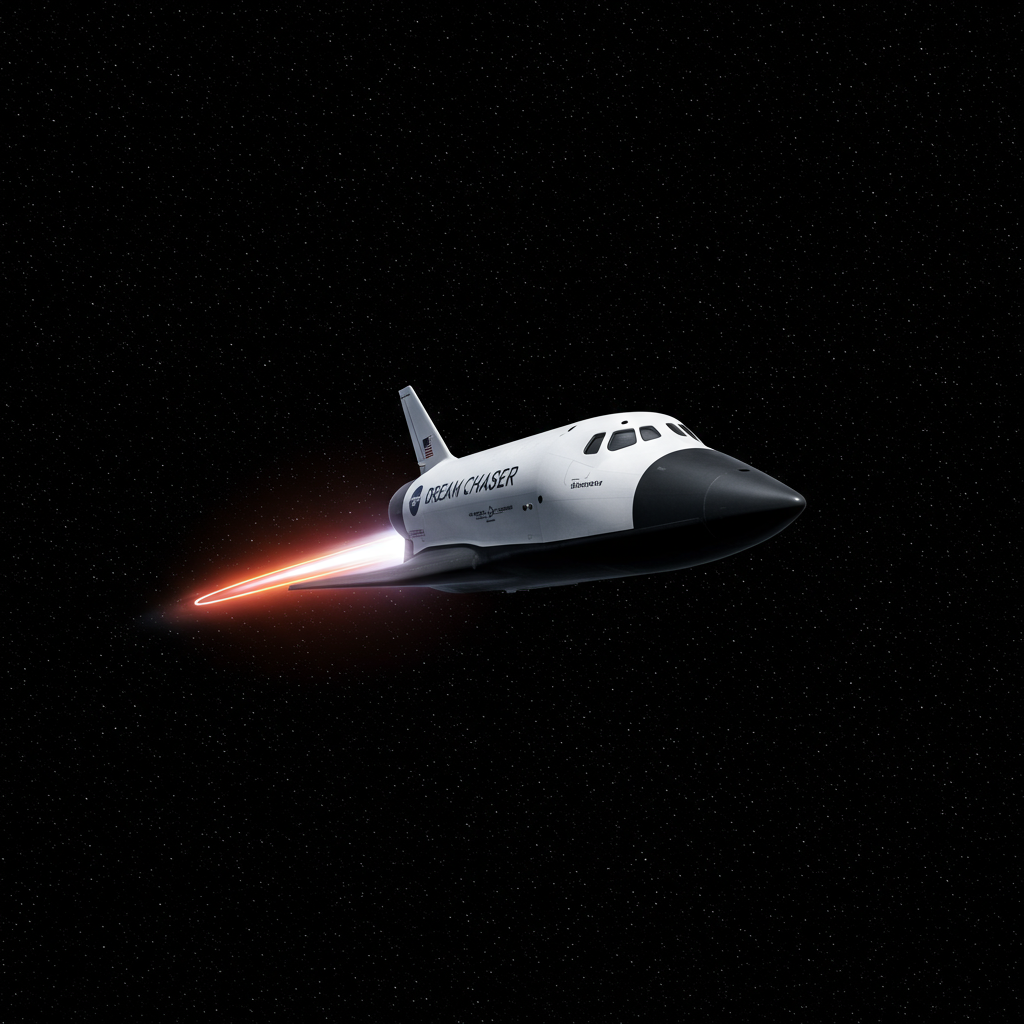Sierra Space’s ambitious Dream Chaser spaceplane, once envisioned as a key resupply vehicle for the International Space Station (ISS), is undergoing a dramatic strategic reinvention. This pivotal shift comes after a significant modification to its NASA contract, compelling the company to redefine the spacecraft’s role and target emerging markets beyond the ISS. The Dream Chaser spaceplane now faces a future focused on versatility, defense applications, and commercial orbital platforms, a substantial departure from its original mission profile.
The Original Vision: A Decade of Promise
Nearly a decade ago, Sierra Space secured a coveted Commercial Resupply Services (CRS) contract from NASA. Their promise was groundbreaking: a privately developed, rapid-reuse spaceplane, unique in its ability to land on conventional commercial runways. This vision was set to mark a first for the commercial space sector, establishing a new paradigm for cargo delivery and return from low Earth orbit (LEO). Under this agreement, the Dream Chaser spaceplane was slated to join SpaceX’s Dragon and Northrop Grumman’s Cygnus as vital lifelines to the ISS.
NASA’s Strategic Contract Change
Earlier this week, the landscape fundamentally altered. NASA and Sierra Space agreed to remove the agency’s guarantee for purchasing cargo flights to the ISS. Instead, the Dream Chaser will now debut in a free-flying demonstration by late 2026, without an ISS docking. NASA has specified it will offer only “minimal support” for this test, delaying any decision on future ISS resupply orders until after the demonstration’s evaluation. This contract modification represents a considerable challenge for the Dream Chaser program. The initial CRS contracts had a combined ceiling of $14 billion across providers. While Sierra Space had already received approximately $1.43 billion, the guaranteed income stream has ceased.
The High Stakes of Space Development
Developing advanced spacecraft, particularly for cargo or crewed missions, demands immense upfront capital. Historically, such programs rely heavily on government backing because commercial customers alone rarely generate sufficient demand to justify the colossal investment. SpaceX, for instance, benefited from billions in NASA funding through its Commercial Orbital Transportation Services and Commercial Crew programs to develop the Dragon capsule and Falcon 9 rocket. The removal of guaranteed NASA revenue means Sierra Space must now independently validate the Dream Chaser’s business case and secure diverse new customers.
A New Direction: Dual-Use and Defense Tech
With the ISS resupply mission no longer guaranteed, Sierra Space is rapidly repositioning Dream Chaser as a versatile “dual-use platform.” This strategic pivot targets both burgeoning commercial space stations and critical defense sector clients. Company executives are vigorously promoting its defense capabilities. Fatih Ozmen, Sierra Space’s Executive Chair, highlighted in a recent press release that this transition will empower the company to deliver “unique capabilities to meet the needs of diverse mission profiles.” These include addressing “emerging and existential threats and national security priorities,” directly aligning with their accelerated push into the Defense Tech market.
Dream Chaser’s Unique Selling Proposition: Flexibility and Reusability
Mid-program pivots are generally rare in the aerospace industry. However, they are becoming more prevalent as space startups adapt to shifting government priorities and the imperative to prove commercial viability ahead of established markets. Traditional aerospace systems were often purpose-built for highly specific missions. Sierra Space, however, is banking on Dream Chaser’s inherent reusability and its distinctive commercial runway landing capability as powerful arguments for its adaptability. The upcoming free-flying demonstration becomes crucial for showcasing this versatility. It offers an opportunity for Dream Chaser to host diverse payloads and demonstrate various orbital capabilities without the complexities of an ISS docking.
Navigating Delays and Deadlines
The path to orbit has seen its share of recent turbulence for Dream Chaser. The spaceplane was recently removed from the manifest for United Launch Alliance’s (ULA) second Vulcan Centaur flight due to scheduling risks. Sierra Space decided to “step aside” to allow ULA to proceed with its crucial Department of Defense certification process. ULA has since announced plans to launch an “inert payload” for its second Vulcan mission.
Despite this launch slip, Sierra Space maintains that its first Dream Chaser spaceplane, named Tenacity, remains on track for its maiden mission before the end of the year. Tenacity, along with its expendable Shooting Star cargo module, completed environmental testing in early May and has since been delivered to NASA’s Kennedy Space Center in Florida for final preparations. The program’s urgency is underscored by the ISS’s planned deorbit around 2030, leaving Dream Chaser a limited window to prove its orbital cargo delivery capabilities. Nevertheless, if Dream Chaser can successfully demonstrate its mission profiles, it could credibly serve multiple customers and carve out a valuable niche as the only winged spacecraft currently on the market.
The Evolving Commercial Space Landscape
Sierra Space’s strategic pivot unfolds within a dynamically evolving commercial space ecosystem. Companies like Impulse Space, founded by former SpaceX propulsion lead Tom Mueller, are pushing the boundaries of in-space transport. Impulse aims for “same-day delivery” of satellites to geostationary orbit (GEO), a service that drastically cuts transit times for commercial operators and offers rapid maneuverability for defense customers. This trend towards rapid, flexible orbital services highlights the need for adaptable platforms like Dream Chaser. Its unique attributes could position it to support the growth of private space stations, orbital servicing missions, and various national security requirements, much like how other innovators are disrupting launch and in-space logistics.
Challenges and Future Opportunities
The reinvention of Dream Chaser is a high-stakes maneuver. While mid-program shifts carry inherent risks, they also present opportunities for companies agile enough to adapt. For Sierra Space, the challenge lies in securing new commercial and defense contracts quickly, proving its capabilities without the guaranteed NASA support. However, its distinctive design, offering both reusability and runway landing, positions it uniquely. Should Dream Chaser successfully validate its versatility through its upcoming demonstration and subsequent missions, it could establish itself as an indispensable asset in the burgeoning commercial space and defense sectors.
Frequently Asked Questions
What is the Dream Chaser spaceplane’s new primary mission focus?
Following a significant contract modification with NASA, the Dream Chaser spaceplane is shifting its primary mission from guaranteed International Space Station (ISS) resupply to becoming a versatile “dual-use platform.” This involves targeting emerging commercial space stations and defense customers. Sierra Space aims to leverage Dream Chaser’s unique capabilities, such as reusability and runway landing, for diverse mission profiles, including national security priorities and commercial orbital transport beyond the ISS. Its debut will now be a free-flying demonstration in late 2026.
How does Dream Chaser’s landing capability differentiate it from other spacecraft?
The Dream Chaser spaceplane is uniquely designed to land horizontally on conventional commercial runways, much like NASA’s retired Space Shuttle. This significantly differentiates it from other commercial cargo and crew vehicles, such as SpaceX’s Dragon or Boeing’s Starliner, which typically perform vertical ocean splashdowns or land vertically. This runway landing capability facilitates rapid cargo return, easier refurbishment, and potentially quicker turnaround times for subsequent missions, offering a distinctive advantage in the commercial space market.
What challenges does Sierra Space face after the NASA contract change?
Sierra Space faces several significant challenges after NASA removed its guarantee for ISS cargo flights. Primarily, the company must now independently fund and justify the substantial development costs of the Dream Chaser spaceplane without assured government revenue. This necessitates a major rebranding and market repositioning to attract new commercial space station operators and defense clients. Additionally, the program operates under time pressure, with the ISS slated for deorbit around 2030, giving Dream Chaser a limited window to prove its capabilities and secure alternative contracts.




